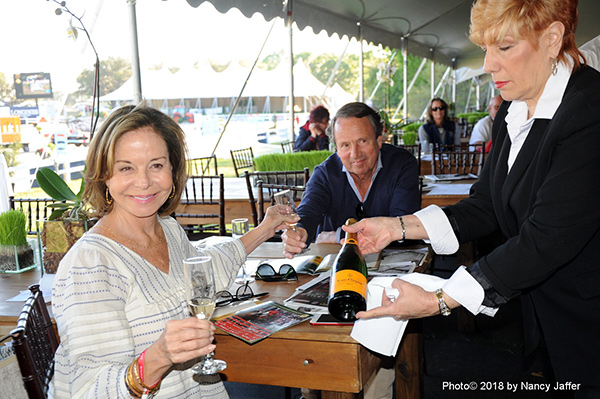Patient buyers looking for a bargain found their match in the Ocala Embryo Auction at Florida’s Live Oak International show last weekend.
The concept takes some explaining. Luk Van Puymbroeck and his Flanders Foal Auction business partner, Gerald Lenaerts, offered 20 embryos with exceptional dam pedigrees. Chin Chin, Plot Blue and Quick Star were among the stallions represented on the bottom line. Flanders was the first outfit in Belgium to try this auction approach, said Luk.
The arrangement enables buyers to keep their purchases, scheduled to be foaled between May and August, in Europe until they are three years old and can begin training. Boarding horses at that age is less expensive abroad than it is in the U.S.
The embryos are flushed from their dams when they are seven days old (which means mares can produce several embryos a year) and are carried to term by surrogate mares, who are trotters and Warmbloods. One of the advantages of the embryo approach, Luk pointed out, is that they don’t have to transport horses from Belgium in order to sell them.
Luk said horses with these bloodlines could go for a six-figure price as three-year-olds, but he believes their value is such they likely would not even be offered for sale in Europe.
“We had the feeling the best breeders don’t want to sell the foals or young horses. By making embryos out of their best mares, they have two or three embryos out of this mare. They say, `Maybe now we can sell one, because we have one or two others in the same year, so it will cover a little bit our cost.’”
The auction presents a way to buy horses with excellent bloodlines at a reasonable cost and have the value increase as they mature.
The auction previously has been held in Belgium and Dubai, as well as England. The partners met Chester Weber – who runs Live Oak with his sister, former Washington International Horse Show Chairman Julia Reid – when the American four-in-hand driving world championships multi-medalist was competing in Stuttgart, Germany last year. The Flanders partners talked with him about hosting the auction in the show’s VIP tent, and he agreed,
Because Ocala has a number of breeding farms (though they are mostly for Thoroughbred racehorses) the partners thought people in the area might be receptive to their concept.
“It’s different than Wellington; Wellington is just the sport,” Luk said of the home of the Winter Equestrian Festival on Florida’s east coast.
Luk had hoped the sale prices would be an average of $20,000, but that didn’t happen – even with champagne and caviar laid out before the auction. Only four lots went for more than $20,000, while several others that didn’t bring spirited bidding were bought back.
The high price of the sale was $30,000 for a granddaughter of Gazelle Ter Elzen, who is a top mount of world number one-ranked rider Kent Farrington and the number one-earning show jumper in the world for 2017, with more than $1.25 million to her credit. The embryo is by Bamako de Muze out of Gazelle’s daughter by Elvis Ter Putte.
Gazelle’s owner, Robin Parsky, was all smiles after she put in the winning bid.
“We have a grandchild. We’re thrilled,” she said. Robin texted Kent – who is recovering from a broken leg – to give him the news and he responded with a text saying this was really a “looooong term” investment. But if Robin has gotten another Gazelle, it could be worth it.
“I like the idea of having the horse grow up in Europe in the same area where Gazelle grew up, with people around who understand and know her. I don’t have to worry about it; it’s going to be well-taken care of,” said Robin.
Although the auction was attended by less than 100 people, bidders also took part by phone and could watch on the livestream. An international group of buyers took part, including several Canadians. Show jumper Francois Lamontagne bid $22,000 for a prospect by Thunder van de Zuuthoeve out of a Plot Blue mare. Canadian Kristine Semrau from Alberta paid $18,500 for an embryo by Diamant de Semilly out of a Cornet Obolensky mare.
Luk pointed out that, “There were not so many people here, but we have a good feeling we have a market here. Most important is that important people bought embryos. We must teach the American people that there is no risk; we have to make an education.”
For his part, Chester said he liked the auction, noting, “One of the challenges in horse sport in the U.S. is we don’t have a history of breeding top Warmblood horses. If you looked at the pedigrees from the auction, they were spectacular. I think it’s an interesting concept, to buy on pedigree and bring that auction to the U.S. I hope it’s able to help people buy what could be great breeding stock and great sport stock.”
He mentioned that riders are among those who have an interest in such an auction. “Not many top riders can afford to invest six figures in a horse,” he pointed out, but the lower prices for an embryo make it more affordable.
Before committing to host the auction again next year, however, he noted,” We have to look through the economics of the whole thing and make sure it makes sense. If it’s sustainable, my guess is, yes, we’ll continue to work with them. It was a good start.” Nancy Jaffer

